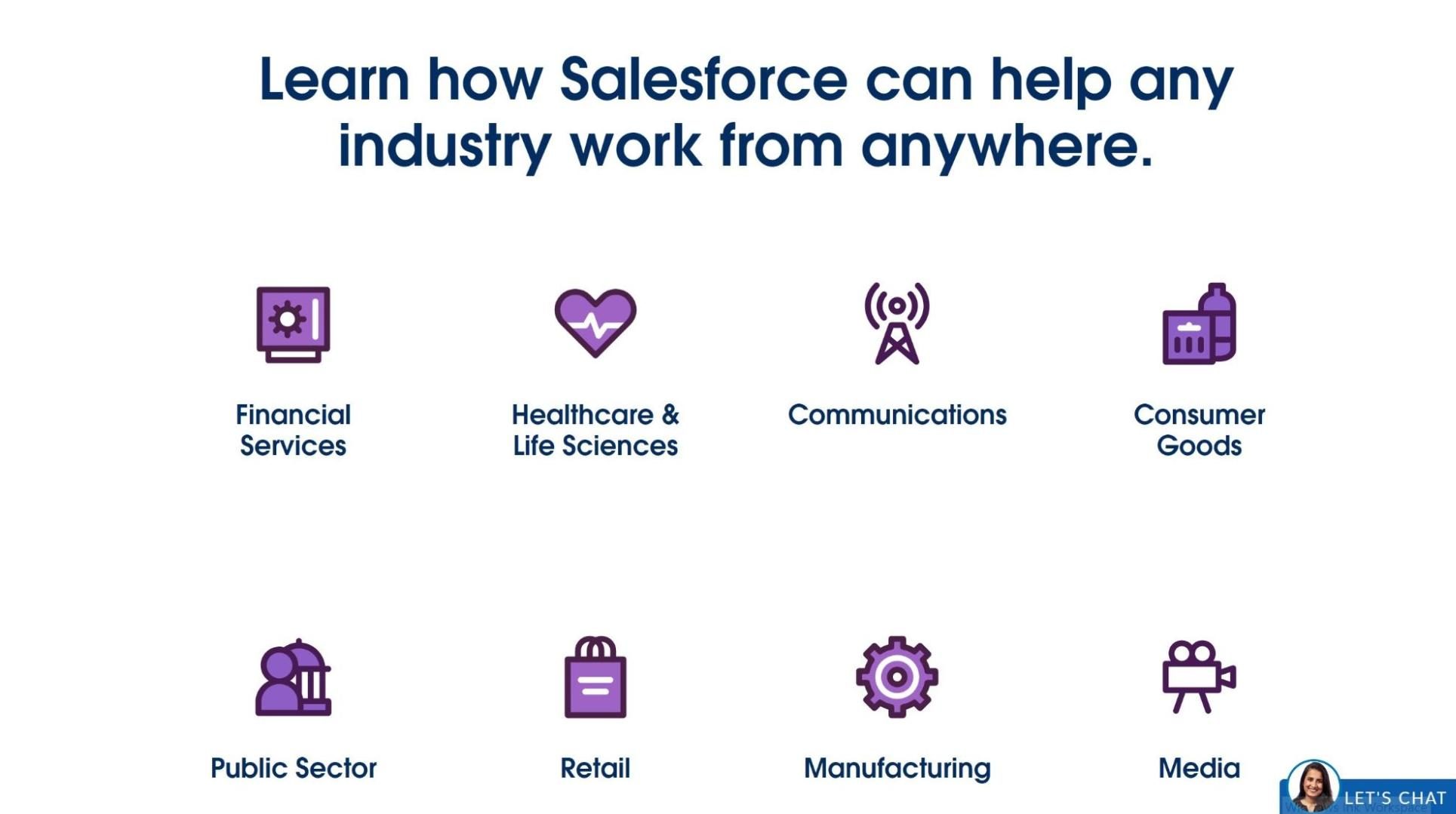Article's Content
Out of a tiny San Francisco apartment, Marc Benioff started a tech revolution in the B2B space in March 1999.
Together with Parker Harris, Dave Moellenhoff, and Frank Dominguez, Benioff sought to create an efficient way to deliver business software applications without the high upfront costs, complex maintenance, and never-ending upgrades.
As a result, the quartet launched a Customer Relationship Management (CRM) system with a disruptive twist: a cloud-based, subscription model, otherwise known as Software-as-a-Service (SaaS).
Fast forward 22 years and Salesforce has earned the trust of many leading brands and recurring subscriptions across the public and private sectors globally. The brand is the first in the cloud computing space to dream up a business model built on partnership.
See how much growth Salesforce has amassed over the years:
- 56,000+ employees
- $226.19 billion market cap
- 66 acquisitions, including Slack, Tableau, ExactTarget
- ~$5B in revenue per quarter, according to Salesforce Q1 report
Legendary.
So, how did Salesforce disrupt the industry with a model no one was familiar with?
The CRM company goes beyond building a great product and a high-performing team. It works hard to establish a strong connection with its customers. As a result, more than 150,000 customers trust Salesforce to help drive sales, service, and marketing results. On top of that, there are also numerous services for Salesforce development for people looking for custom solutions. Salesforce didn’t achieve this success overnight. Instead, the brand followed a strategic, replicable process that any brand could adopt.
This essay comprehensively summarizes the marketing strategy that helped Salesforce build the largest B2B partner ecosystem. You’ll also learn how Salesforce satisfies multiple audiences and sustains a thriving community of 1,300+ groups across 90 countries.
If you want to create and distribute insightful, engaging, customer-centric content that drives sales and inspires loyalty, you’re most certainly in the right place. This is Salesforce’s growth story, packed with actionable insights.
Salesforce’s Aggressive Marketing Strategy in the Early Days
Let’s go back in time for a bit. In 1999, Salesforce co-founder Marc Benioff quit his VP position at Oracle after a 13-year stint to create the first SaaS CRM. Together, Benioff and his team made the first version, which looked like this:
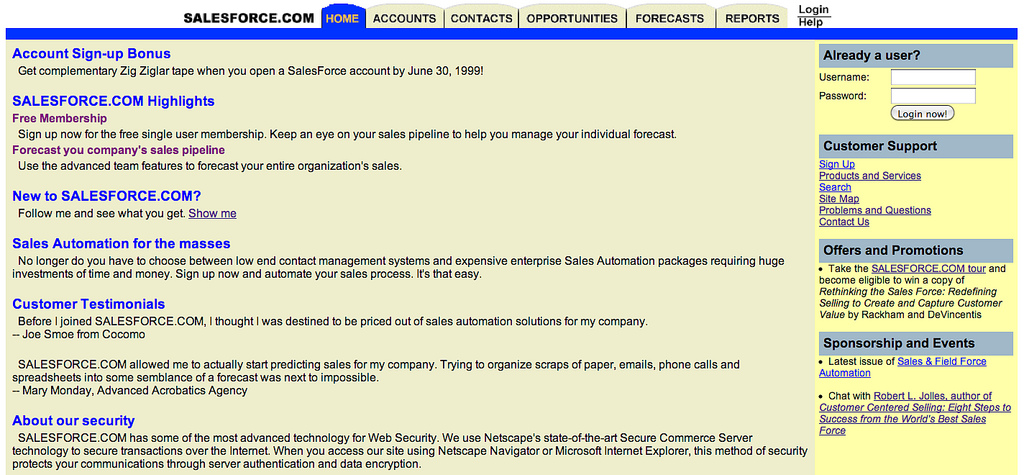
Vintage, right? That was only the beginning of a revolution in the tech space.
To get a buy-in from prospects, Salesforce adopted an aggressive marketing strategy to enforce its positioning.
Benioff positioned himself as the leader of a new movement: the end of software.
In his book, Behind the Cloud, he shares brilliant marketing, events, and sales strategies. One of them is nailing a brand’s market positioning.
The Salesforce CEO was convinced that his cloud-based, subscription CRM was the future the people didn’t know they needed. So, along with his team, he declared and led the war against the established software industry.
It started with a protest staged in February 2000 at the Siebel User Conference in San Francisco.
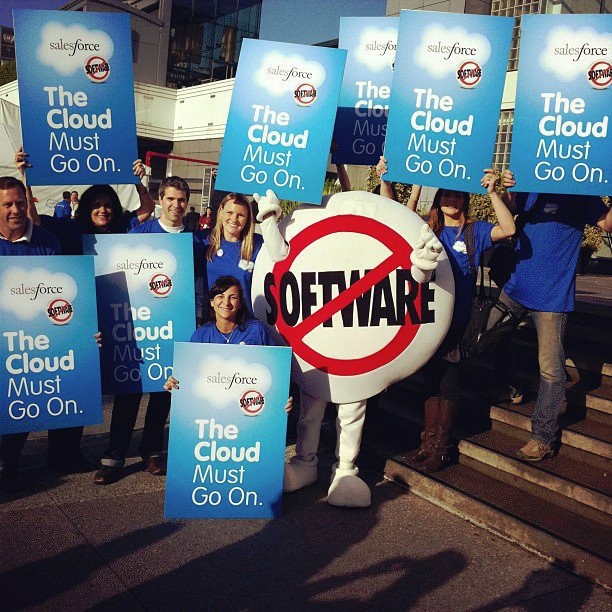
[Source]
The protesters (paid actors) carried signs with bold messages calling for the “end of software” and chanted anti-software slogans to attendees as they walked past the protest. He even arranged for actors to play the part of reporters covering the protest for a fake news channel, “Channel 22.”
Dramatic, yeah? But super effective!
The marketing stunt’s goal was to shift attention away from the enterprise software solutions (Salesforce’s competitors) and toward the company’s disruptive solution. Benioff went up against industry leaders through those protests, positioning Salesforce as the sole solution for salespeople working in CRMs. Even the messaging on their website reflected their position:
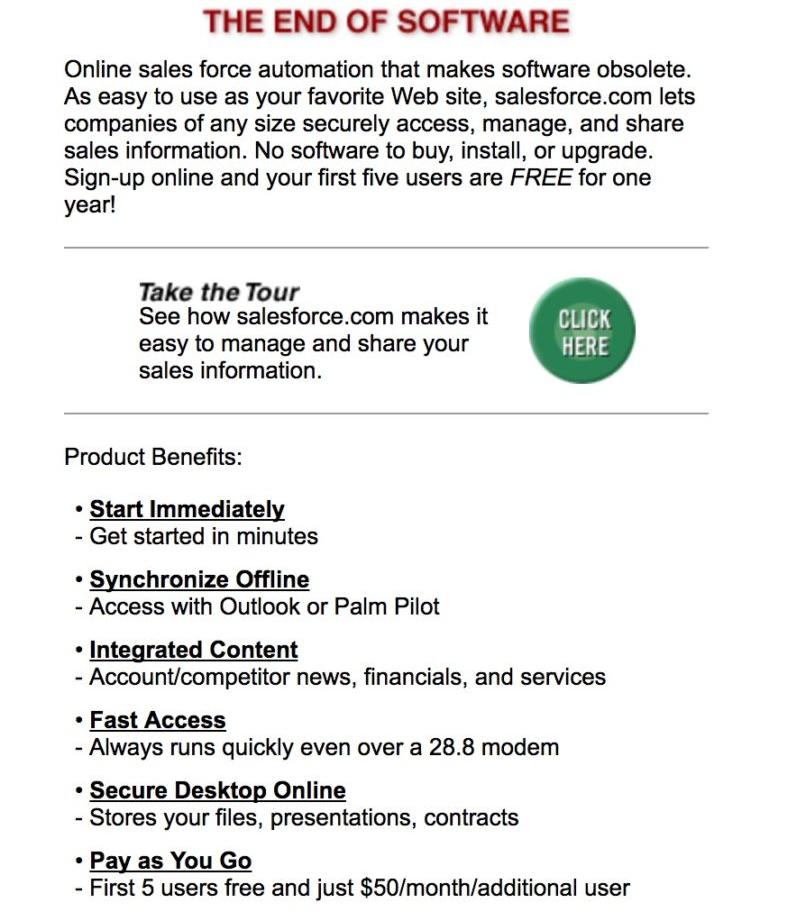
[Source]
But Benioff didn’t stop there. He followed up with a military-themed, anti-software party where guests brought an old piece of software to throw in the trash.
The result?
Salesforce—once the underdog—became the top dog relied on as a trusted friend and partner. Salesforce got media coverage from major publications such as the New York Times, Forbes, and The Wall Street Journal. That’s why the cloud service provider giant has grown to a $226.19 billion valuation, and Salesforce was recognized as the world’s #1 CRM for eight years running.
For outsized growth, Benioff advises startups to be unafraid to go toe-to-toe with industry leaders or to replace them. “Always ask yourself, ‘What’s my message?’ Position yourself either as the leader or against the leader in your industry.”
Salesforce’s Strategy for Satisfying Multiple Audiences
A single customer persona in a B2B company can be detrimental to the brand’s health. That’s because most B2B companies serve more than one customer segment.
Designing a content strategy that addresses multiple audiences can be a long, frustrating process. However, an approach that acknowledges how you serve various audiences will help you reach, engage, and connect better with each of your audience segments.
Salesforce serves many different industries, and a banker using a CRM has different needs from an event manager using one. The navigational menu on Salesforce’s website shows these multiple audiences.
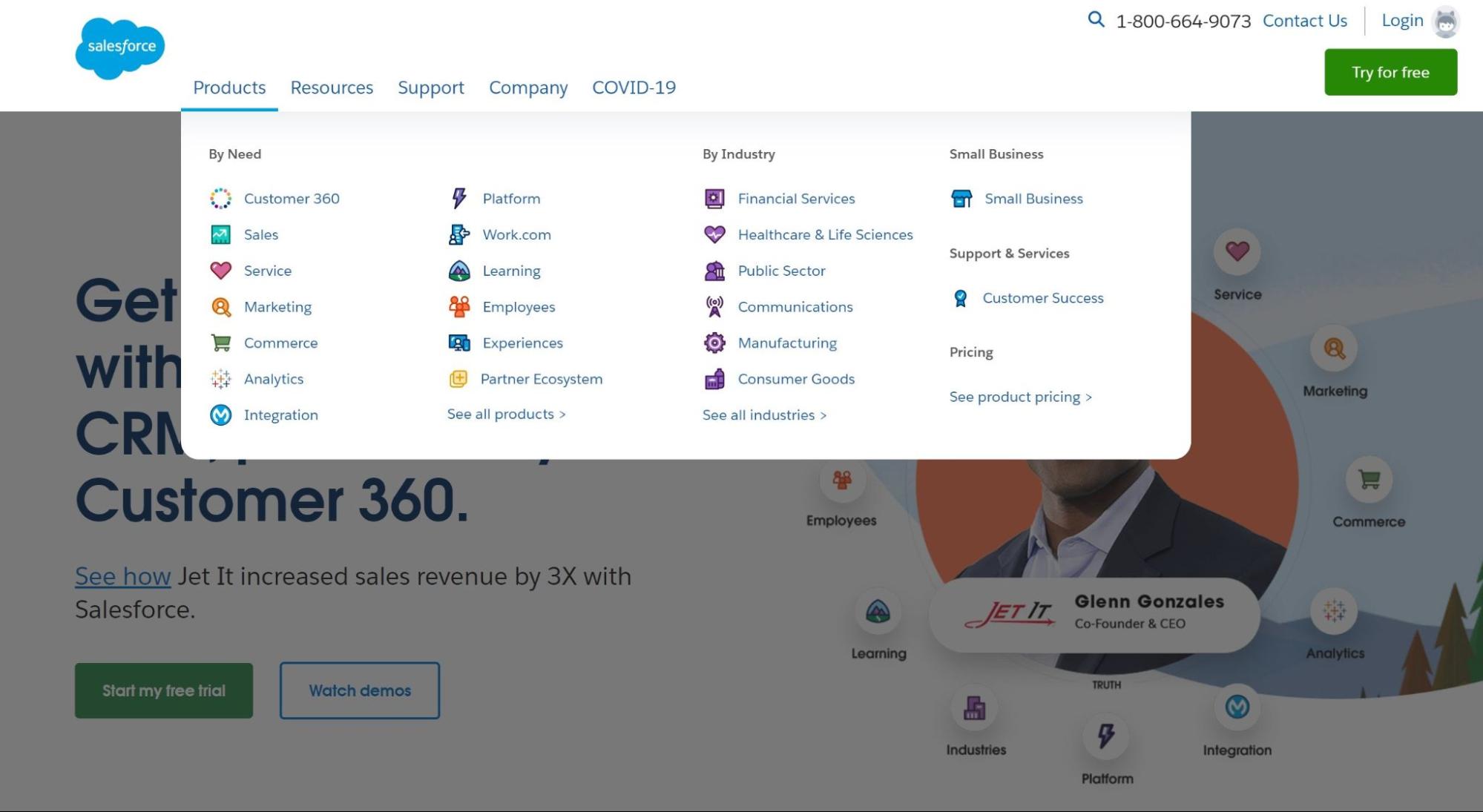
When you hover on the “products” tab on the menu bar, you can see how Salesforce targets each audience segment. There are two major categories:
1. By need: Visitors can find a specific solution or product that Salesforce offers.
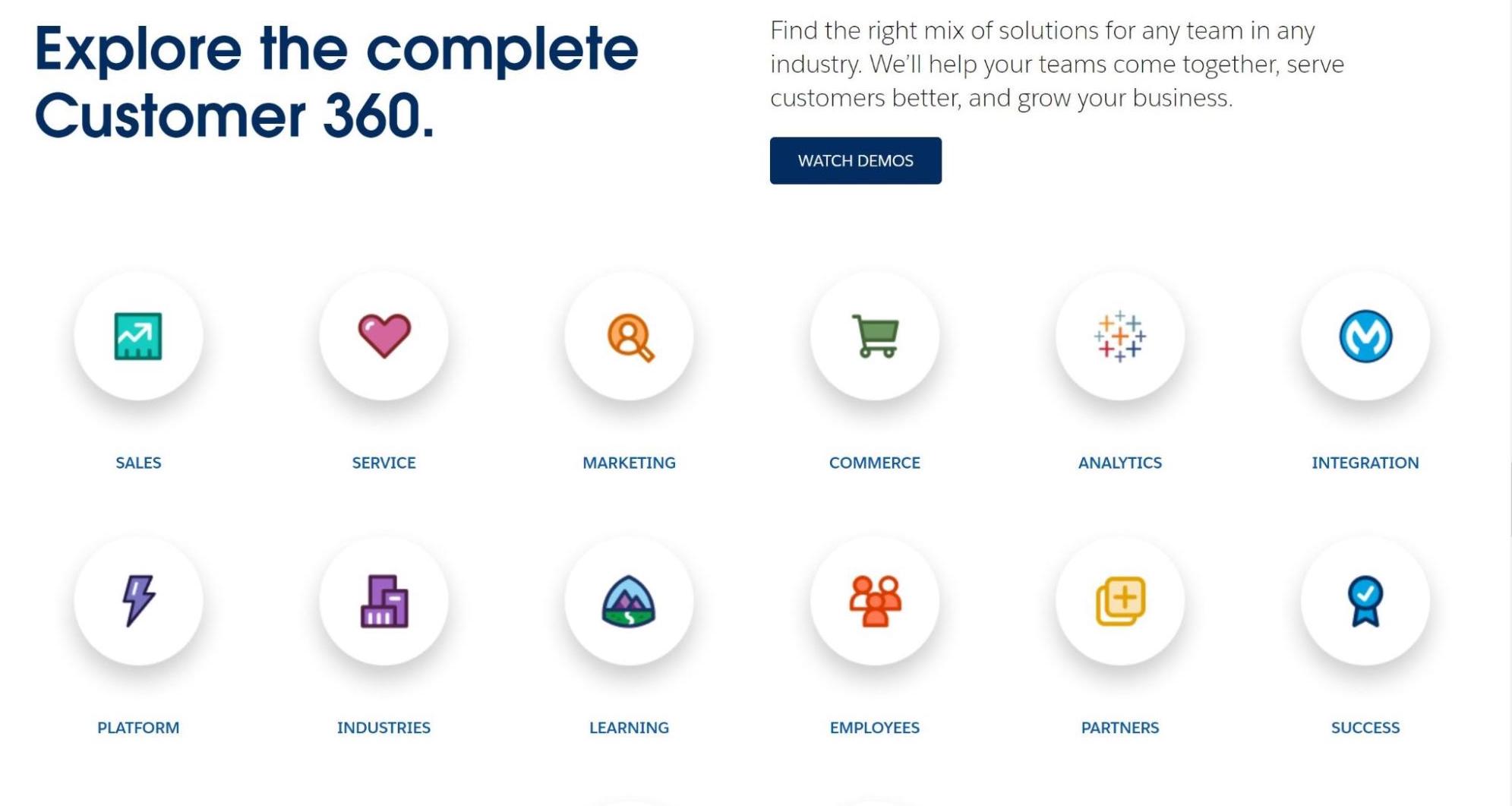
2. By industry: Visitors can quickly identify with their niche and see how Salesforce drives results in that industry.
A prospect from any one of these industries can read success stories from companies similar to them, building their trust that Salesforce can help them get equal or better results and encouraging them to start their own journey with Salesforce.
These multi-persona landing pages attract over 5000 monthly visits from organic traffic alone, according to Ahrefs. That’s over 5000 people searching for “Financial CRM” or “Health CRM” every month who end up on an optimized Salesforce landing page that addresses their specific pain points.
Assuming 3% of those visitors like what they see and convert:
0.03 x 5000 visits/month = 150 new customers every month.
That’s over 1800 new customers per year.
If we assume that Customer Lifetime Value (CLV) is spread over < 4 years, and the average deal size is estimated to be $20,000 per year, then we’re looking at an estimated $12,000,000 in revenue per year on the back of these assets. (This is still an assumption).
In reality, Salesforce does ~$5B in revenue per quarter, according to the Salesforce Q1 report. That’s a whopping estimated ~$20B in revenue per year.
You can make this strategy work for your brand by creating landing pages tailored to your customer needs and segmenting those needs. Use these landing pages to drive traffic and boost conversions. Like Salesforce, you can use specific customer success stories, testimonials, and relevant metrics to attract, engage, and convert prospects into paying users.
How Salesforce Uses Customer Success Stories to Inspire Prospects to Take Action
Everyone loves a good story.
Compelling stories do more than keep our eyes glued to the screen. They give us a glimpse into what our lives could be if we take similar action. Such stories also allow us to learn from the experiences of others, and they have the power to shape our thinking and influence our next steps. It’s pretty powerful.
Marc Benioff calls stories the “new currency” of Salesforce. “Stories are an integral part of a customer’s journey at Salesforce,” he said. “It’s how we measure and communicate success, inspire customers and ourselves.”
These customer success stories allow prospects to relate to existing customers and envision the same success for themselves.
Salesforce’s homepage leads with a customer story: “See how Jet It increased sales revenue by 3X with Salesforce.” Instead of relying solely on product demos like most SaaS companies, Salesforce uses the company name and incorporates metrics to demonstrate the growth they’ve created.
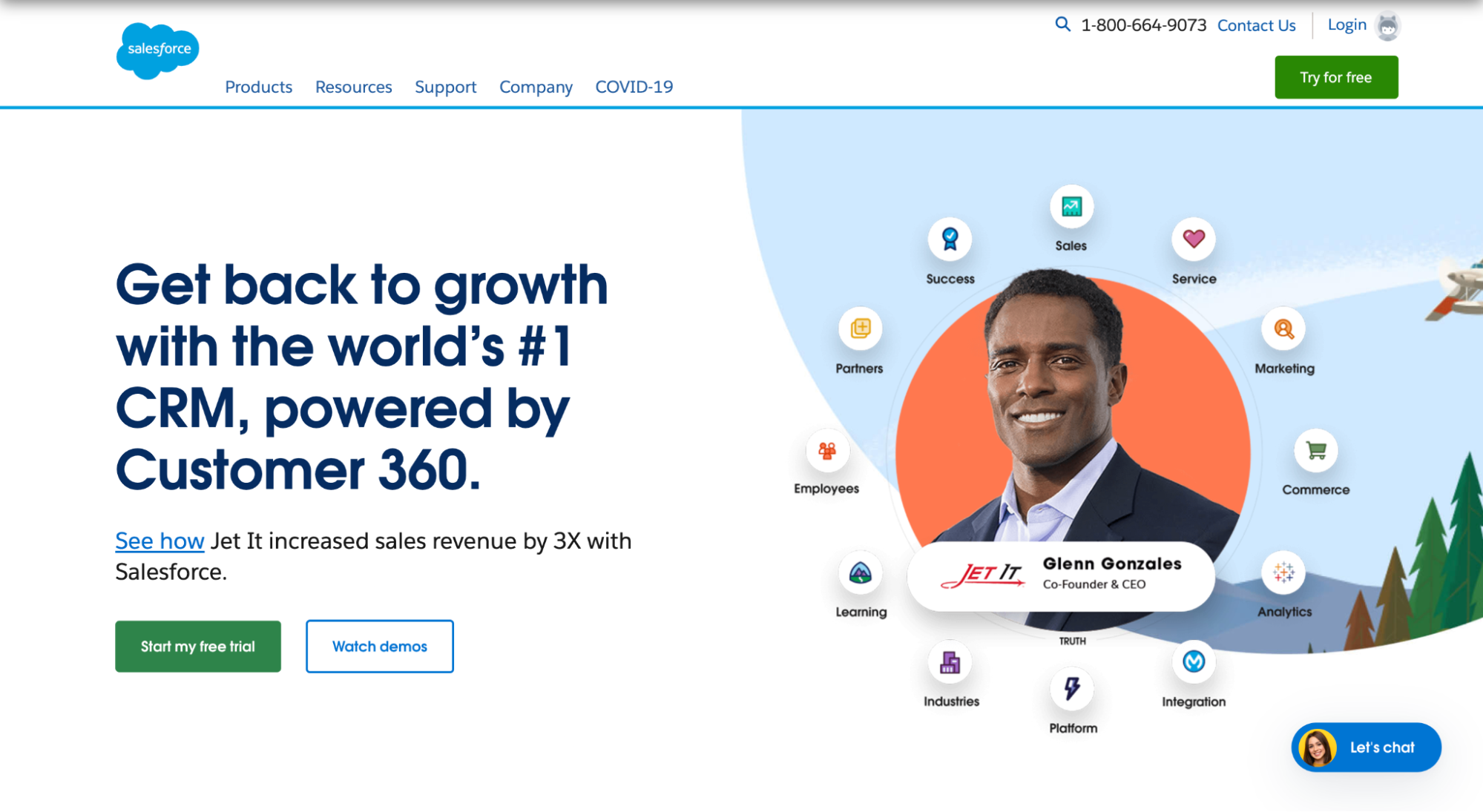
They’ve also included a photo of the smiling customer paired with a name, job title, and the company logo (which you can now design yourself using a free online logo maker, by the way). Notably, Salesforce focuses more on its customers than on how great the CRM’s features are.
Salesforce also included a “Customer Success” section in the footer, listed under the “New to Salesforce” column. It comes before product pricing. This small yet significant detail demonstrates how much they truly value the customer’s success. Customer success stories, after all, are an integral part of the consideration stage of the buyer journey.
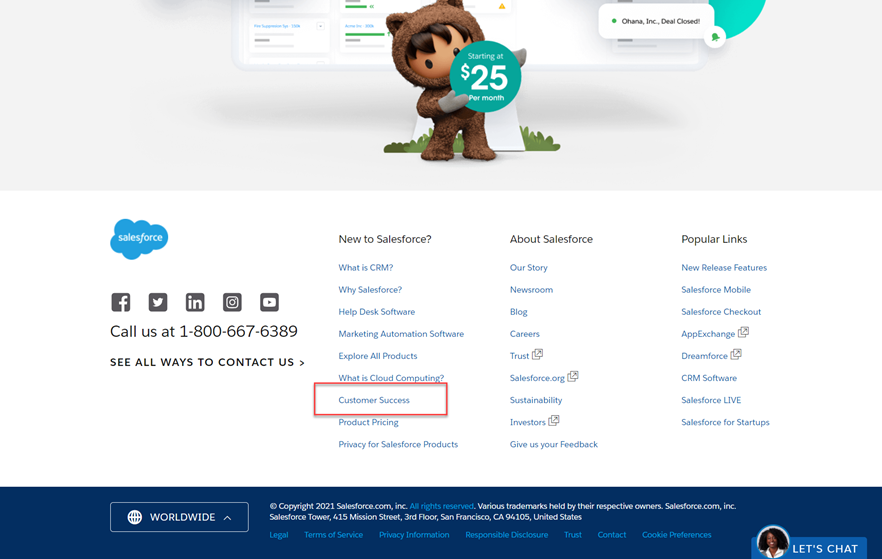
Salesforce uses the same strategy on the customer success landing page itself.
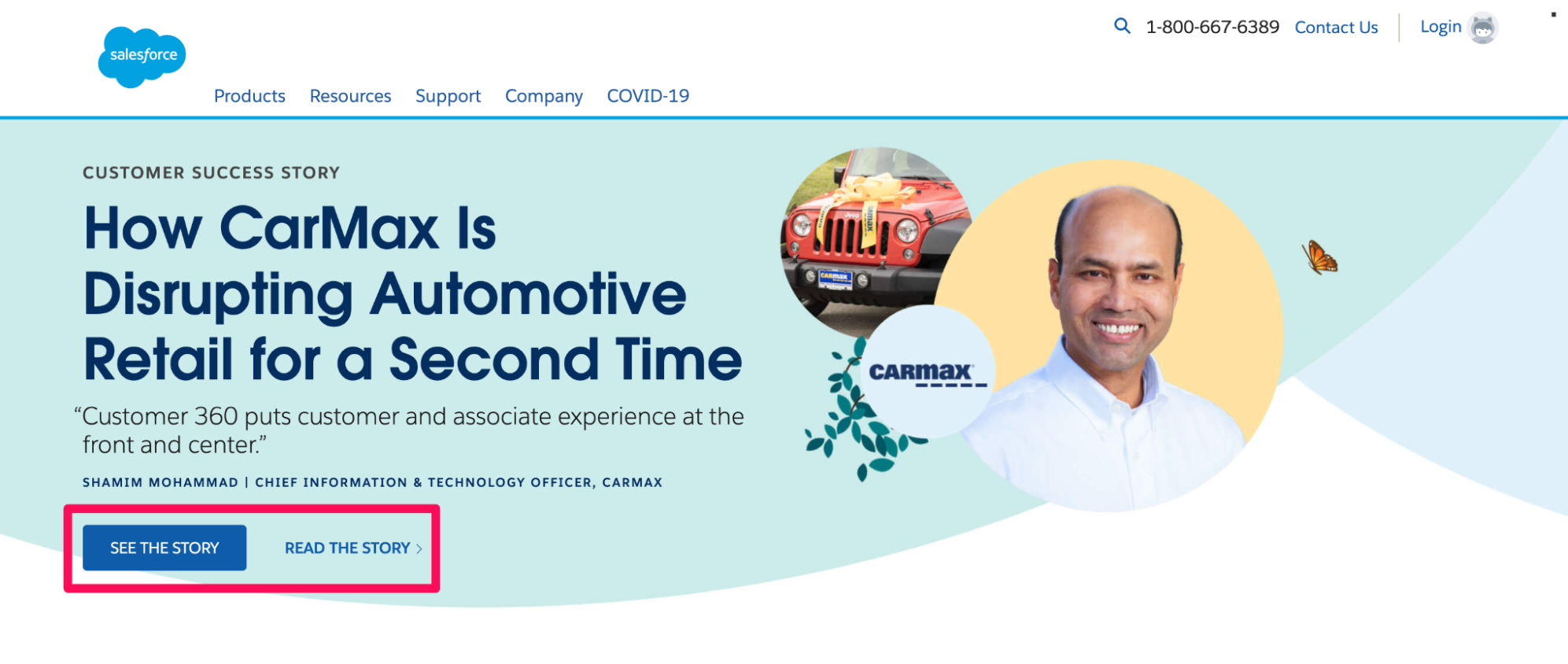
Notice how the primary CTA is the video—an opportunity to pull customers into an experience beyond words. No wonder the page attracts over 3.4K monthly organic visitors, with a live backlink profile of 17.3K, according to Ahrefs.
Showing how your products help your customers succeed is a surefire way to build authority and be seen as an industry leader. Apart from leveraging social proof to establish credibility and drive conversions, Salesforce also adopts other marketing tactics to get desired results.
How Salesforce Uses the Keyword Glossary Strategy to Dominate SERPs
People use Google as a dictionary, searching for unfamiliar terms and acronyms they might have picked up at a conference or during a chit-chat with a connection.
Creating a glossary—a landing page for defining terms around your niche and industry—provides value for prospects searching for that info and ensures that interested parties find their way to your site when they’re trying to learn more.
People who search for these related terms are more likely to convert than regular visitors. When you give them the definition they need, you not only bridge their knowledge gap but you boost your organic search ranking in the process.
The keyword glossary strategy has worked exceptionally well for Salesforce. A quick look at their top pages based on traffic and value reveals that definition pages represent a significant portion of their site’s traffic.
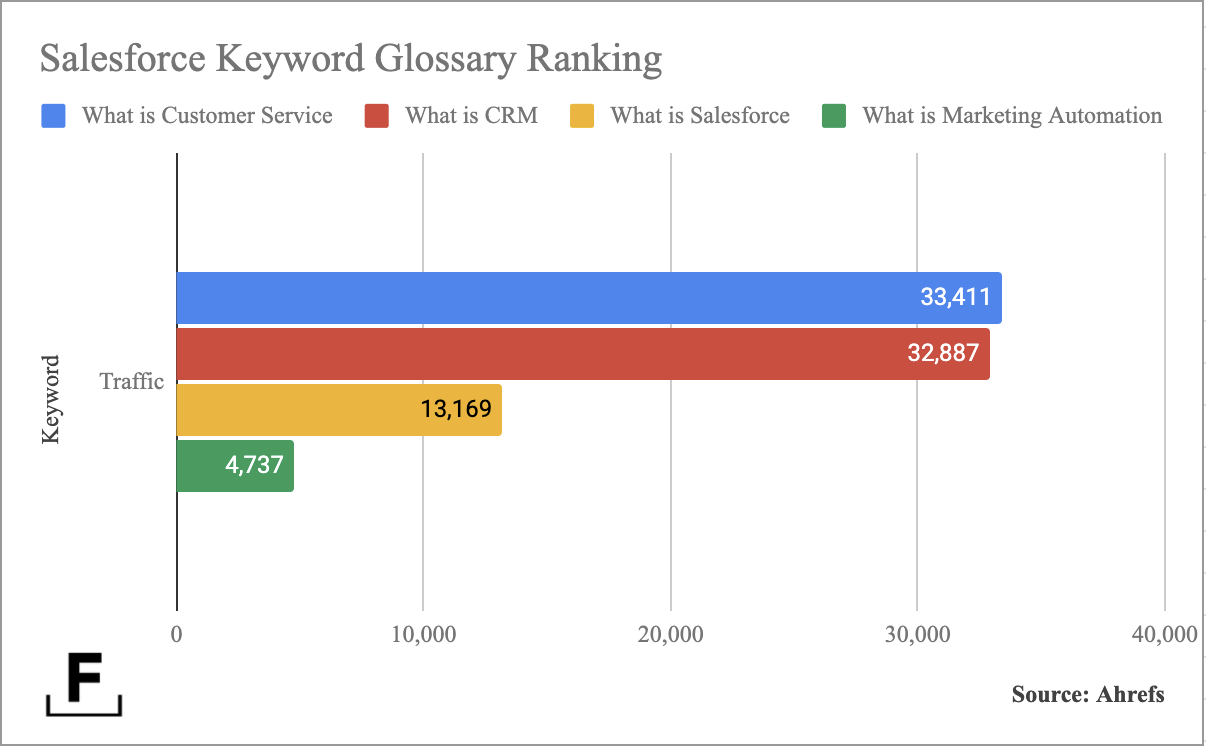
Mind-blowing, right?
A definition query like “what is CRM” has over 32,000 organic searches every month, with a traffic value of over $650K.
Take some time to think about your industry. Would a glossary be valuable to your customers? It may be if your product falls under a relatively new niche like cryptocurrency or is part of an industry with jargon most customers will struggle to understand. In that case, you can help prospects find the answer they need and position your product as the go-to solution for those needs as well.
How Salesforce’s AppExchange Revolutionized the Way That B2B Ecosystems Operate
One of the reasons why Salesforce is considered the largest B2B partner ecosystem is its AppExchange.
AppExchange is a marketplace for apps, plugins, tools, and templates built by independent developers and companies (independent software vendor partners). Users working in sales, marketing, customer service, or human resources can distribute their app(s). Consultants and professional service firms such as Deloitte provide technical support and project execution for companies looking to migrate to Salesforce or boost their current usage.
Not only do users get the help they need, but professionals also get a chance to get hired. No wonder International Data Corporation (IDC) estimated that the Salesforce ecosystem would create 4.2 million jobs worldwide through 2024. That’s an estimated $1.2 trillion in new business revenues to local economies.
AppExchange also makes it easy for visitors and users to find apps. Its personalization feature recommends apps based on your industry, niche, and business:
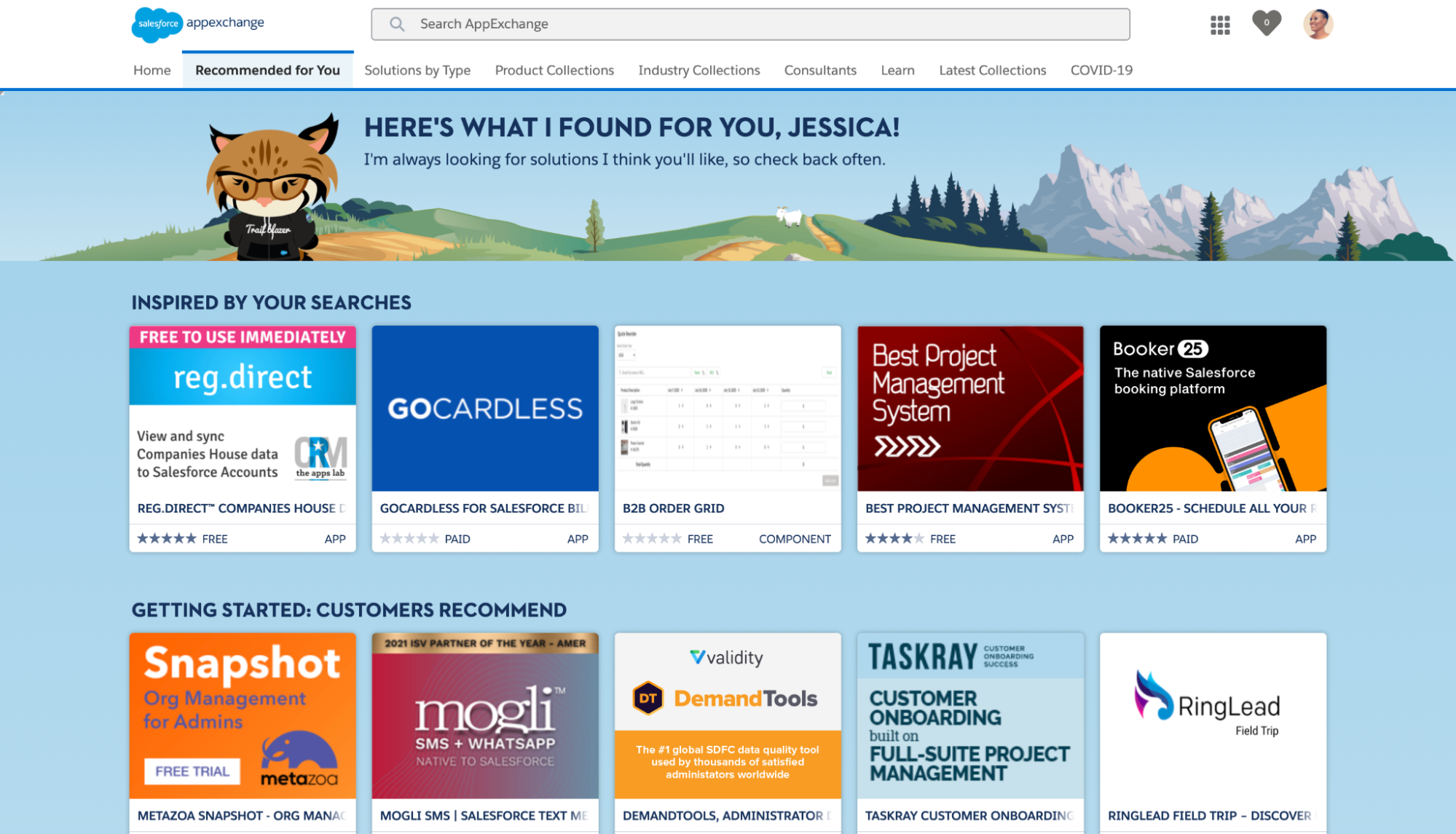
Salesforce also educates AppExchange users and members. They have a partner community where members collaborate, innovate, learn, and connect. The community offers real value to users through downloadable guides, webinars, events, reports, etc.
Salesforce’s Trailblazer Community: Leveraging Events and Community Content to Boost Engagement and Inspire Trust
Humans love to connect and feel like they are a part of something great. Salesforce understands this, which is why they created a healthy, thriving community of industry experts, innovators, professionals, and even students.
The Trailblazer community is the perfect spot for connecting with like-minded people, getting questions answered, and planning meetups worldwide. Its rich resource center offers guides, reports, whitepaper, listicles, and other helpful visual content. Here’s how Salesforce keeps the community engaged and thriving:
Niche Community Groups
There are over 1000 trailblazer community groups. These communities satisfy the innate desire of humans to connect while offering and receiving value.

You can join a community group in your area of interest or skill set, depending on your current needs.
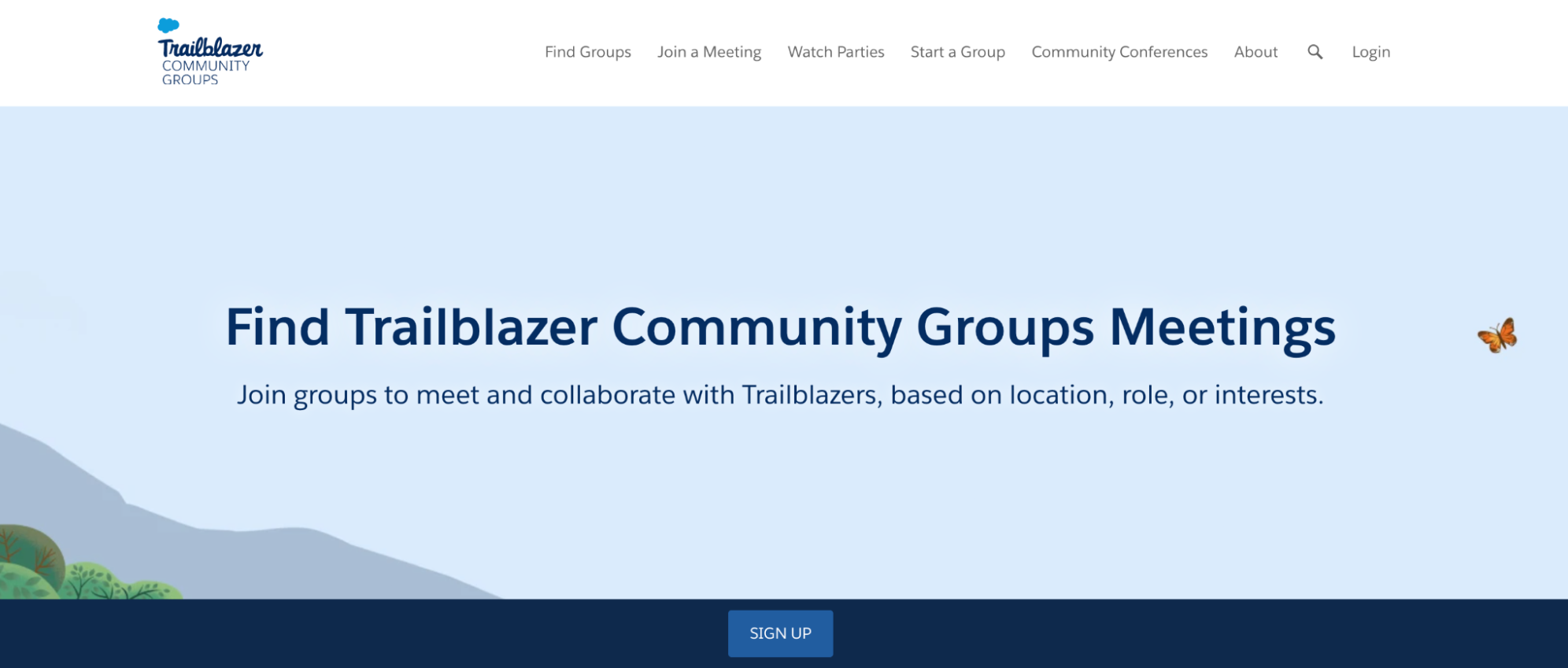
These groups meet up regularly, either virtually or locally, giving professionals a chance to share knowledge, ideas, and best practices, collaborate, network, and build lasting relationships.
Q&As
Salesforce Q&As let members get support from a global community of users from different industries at different levels of their careers, making them growth opportunities for novices and experts alike.
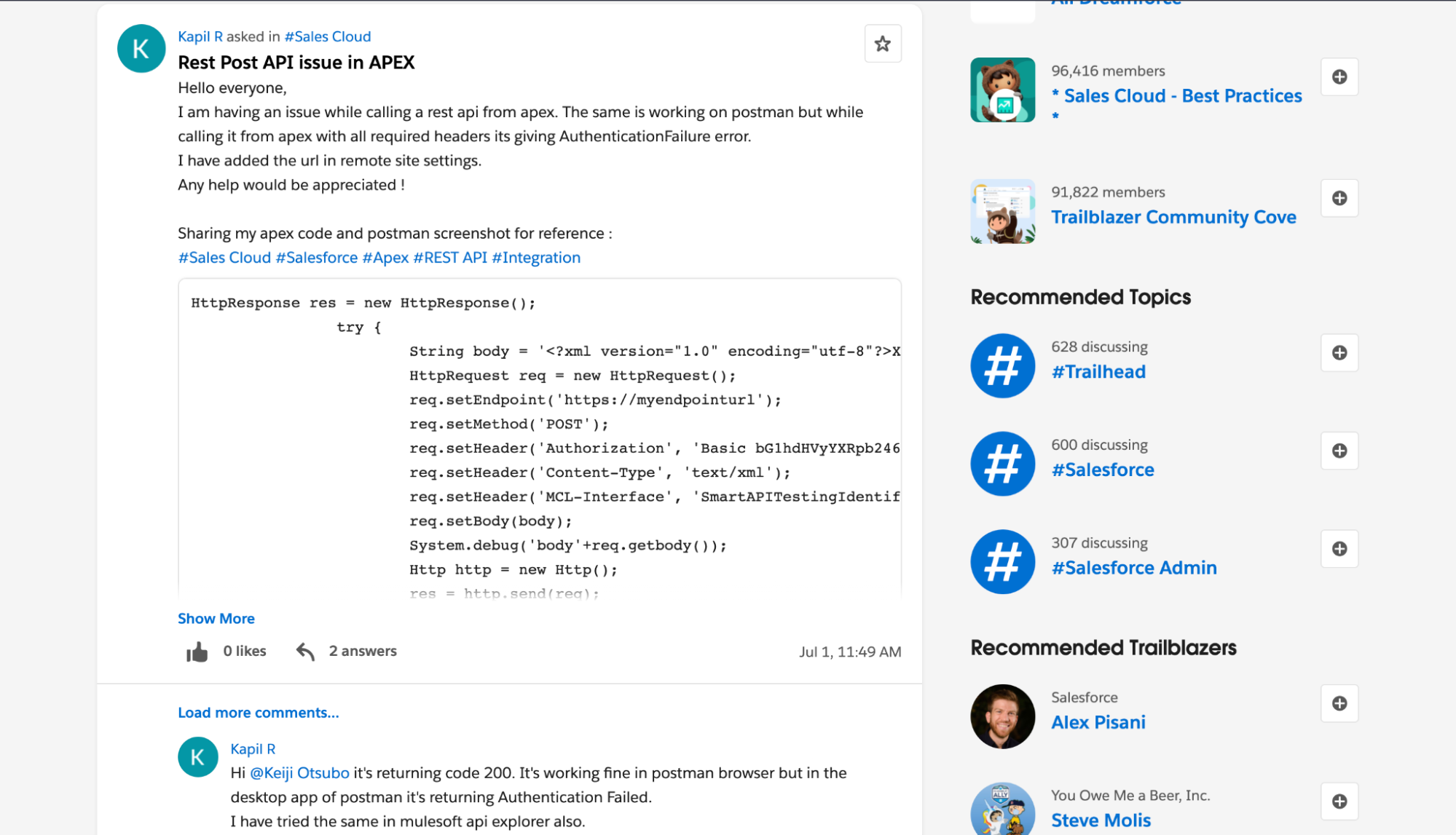
Recognizing the top contributors who provide the most value to other members is another way Salesforce secures buy-in from their customers. Most Trailblazers go above and beyond to provide helpful answers to their community. As a result, some have become significant contributors, achieving the Salesforce MVP status. Some MVPs even flaunt that achievement on their Linkedin profiles.
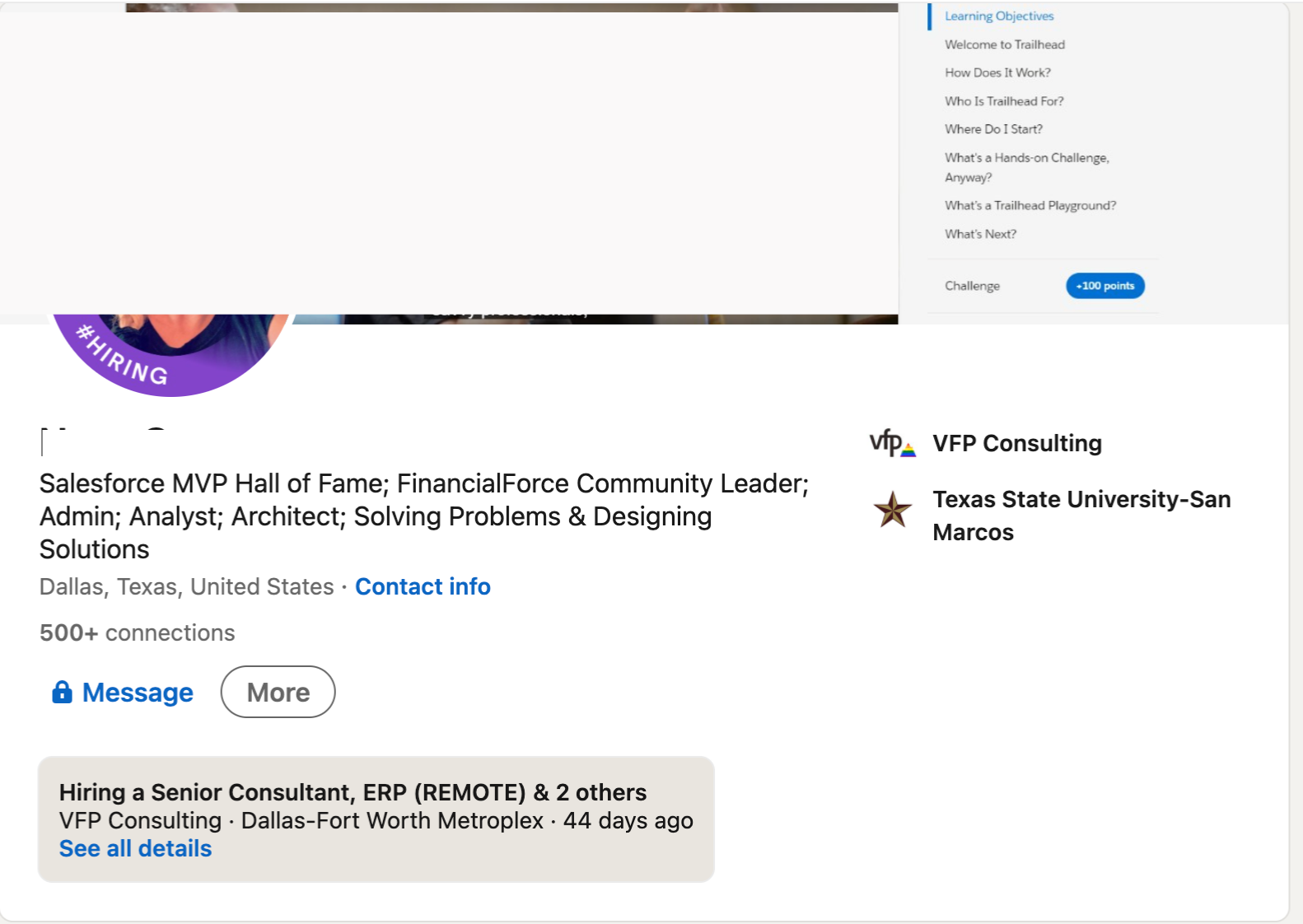
It’s a subtle yet effective marketing strategy.
IdeaExchange
Another effective marketing initiative from Salesforce is the IdeaExchange, which provides product managers with an opportunity to share their ideas with the community and collaborate with other PMs to help shape and improve Salesforce’s product roadmap.

The IdeaExchange does two things:
- It aligns customers behind Salesforce’s vision, making participants feel like they have a stake in the game (they really do).
- It guides the Salesforce product development process.
With these insights, Salesforce can focus on planning and developing releases that matter to the customer, delighting them repeatedly. Salesforce also gives participants something to look forward to by publishing the ideas that get the most attention during the prioritization stage.
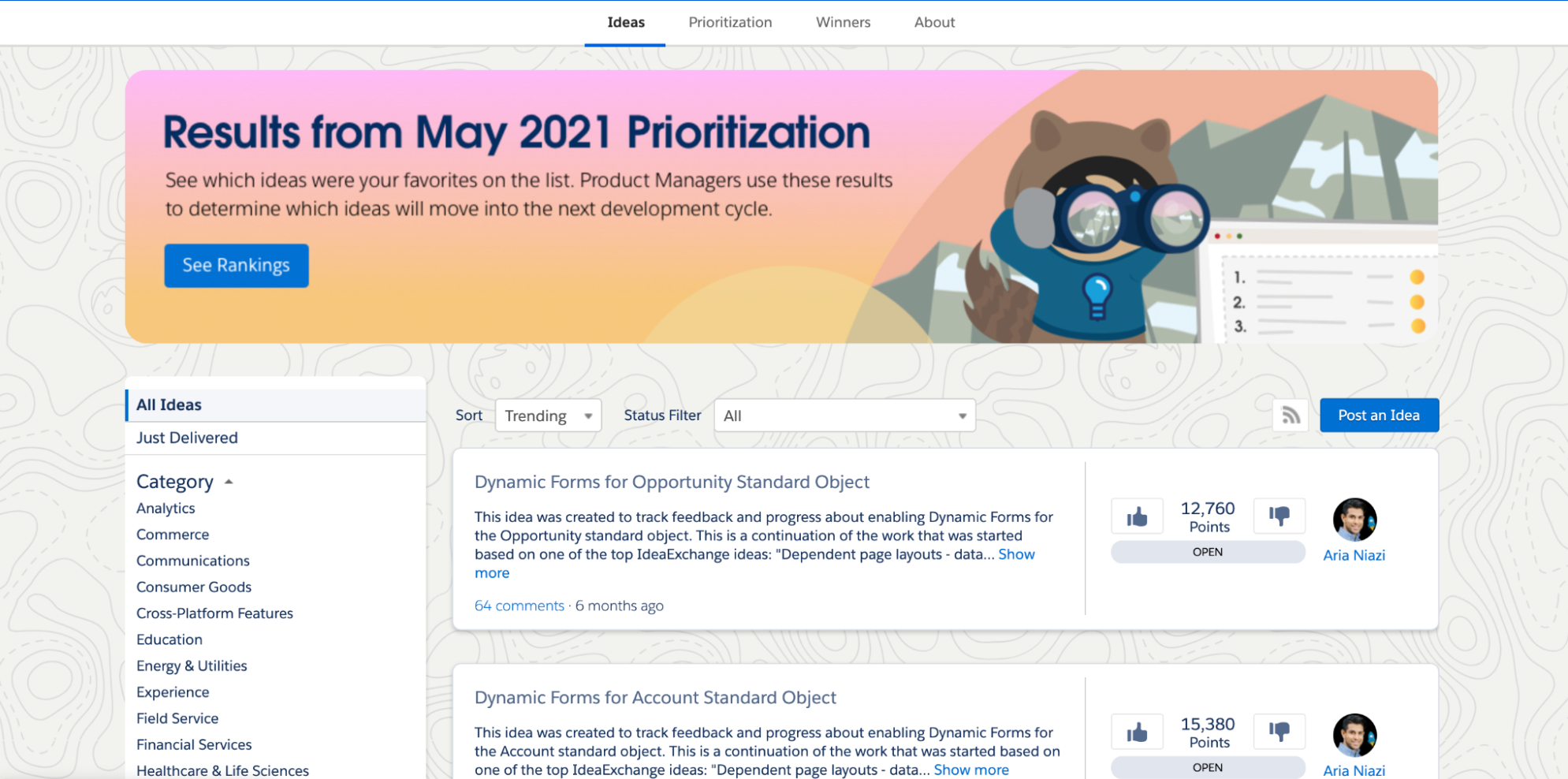
Project Managers add top results to the product roadmap. This way, customers know that their voices will be heard and valued, encouraging them to throw themselves into the prioritization process. Salesforce is also transparent about the development status and when to roll out these features/products.
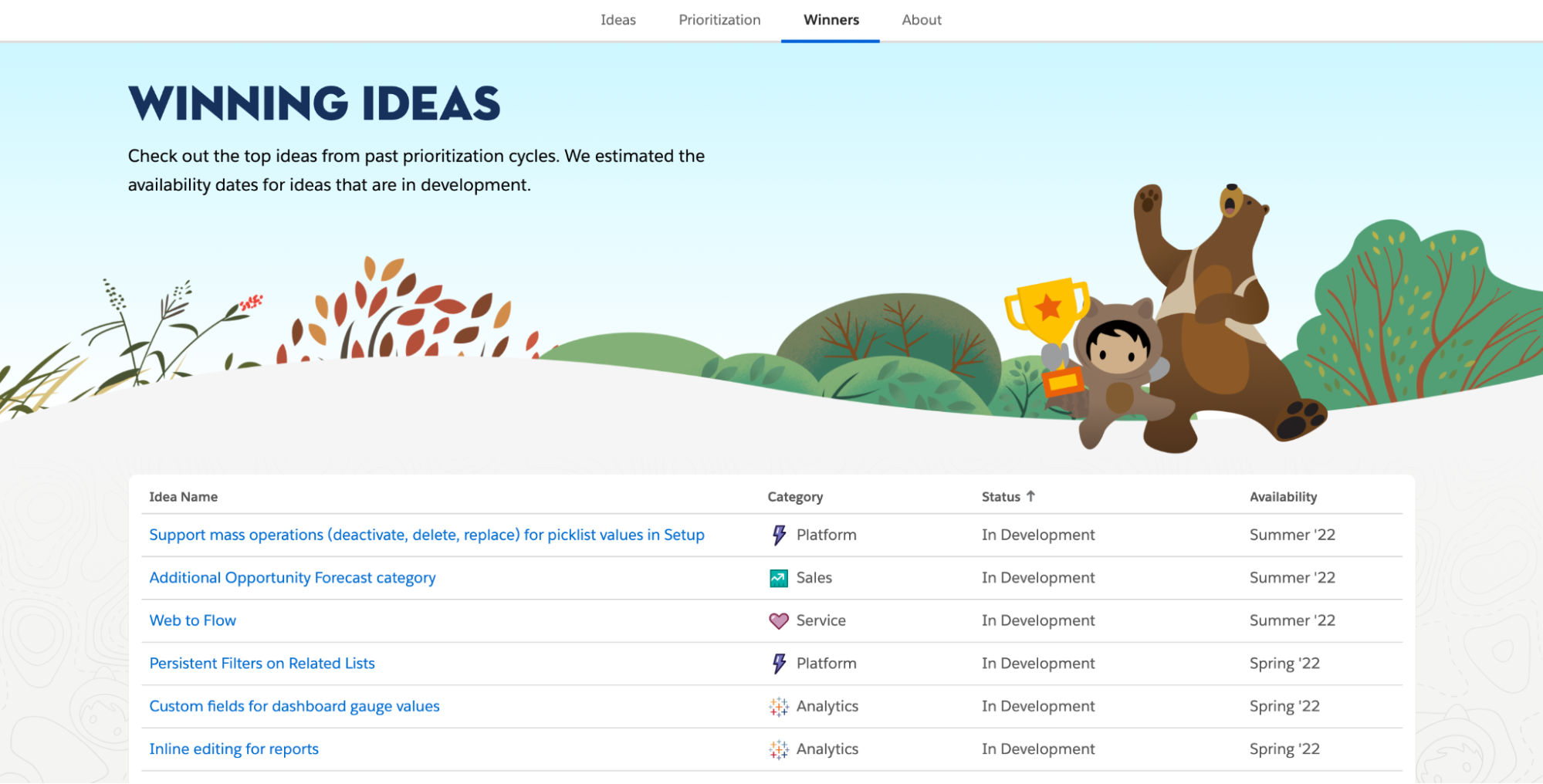
Salesforce’s Niche, Up-to-Date Resources
Salesforce leverages niche resources to educate community members and visitors.
For example, they have separate YouTube channels for different industries.
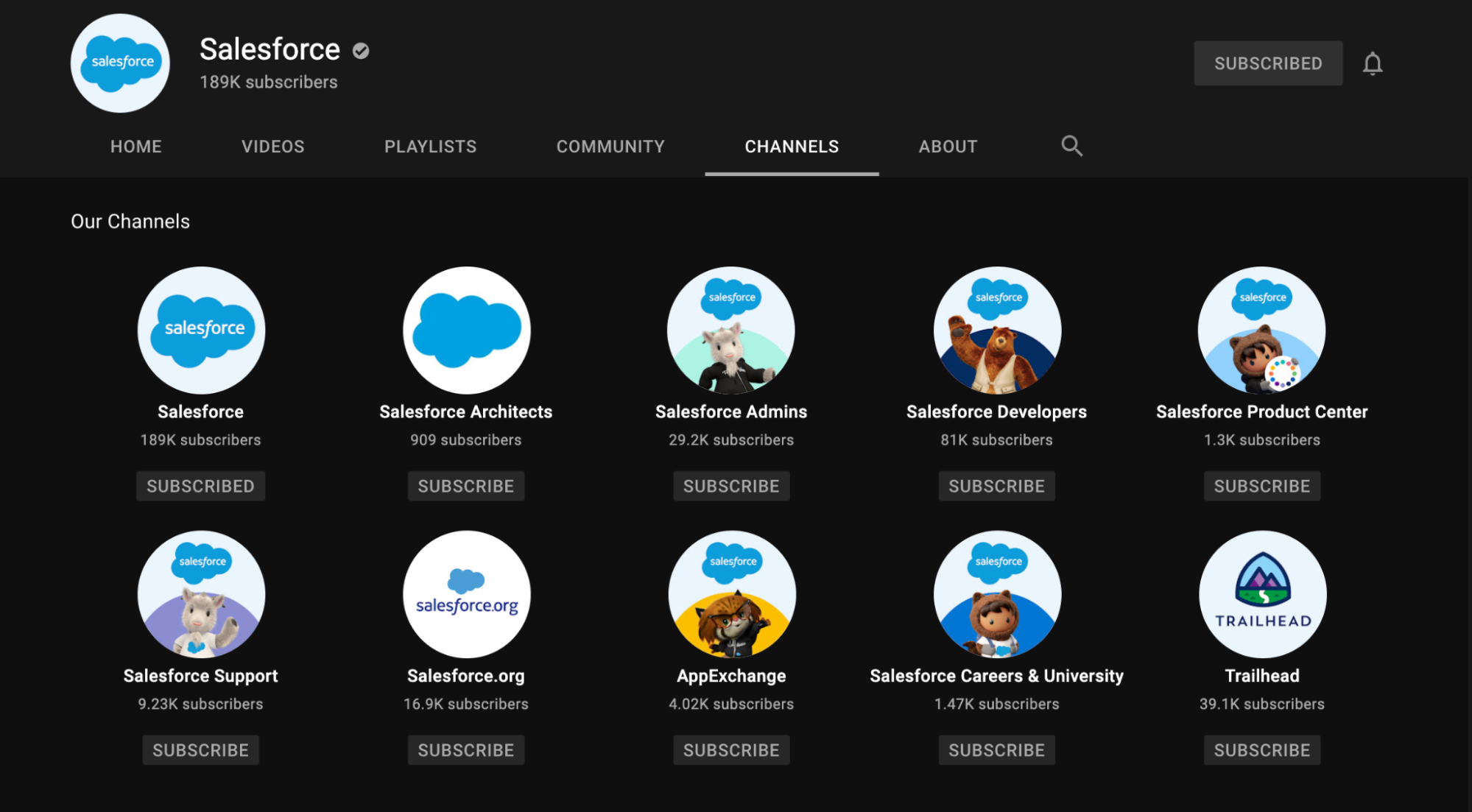
Each of these channels attracts a large following:
- Salesforce official YouTube channel: 189k
- Salesforce admins: 29.2k
- Salesforce developers: 81k
- Trailhead: 39.1k
According to VidIQ, Salesforce’s official YouTube channel has 6.45M monthly views, with average daily views of 215K. One of the ways Salesforce attracts more visitors and gains subscribers is by creating rich visual content, like this set of videos that share insights on remote/hybrid work lifestyles.

Creating these resources shows the community that they care about their wellbeing and are interested in helping them manage their work lives.
Salesforce’s Dreamforce
Dreamforce is the cloud giant’s largest event of the year, with over 170k registered attendees at the 2019 event in San Francisco.

[Source]
The conference attracts thought leaders, industry pioneers, and thousands of IT professionals. 2019’s in-person session featured over 2700 sessions, workshops, and keynotes delivered by industry leaders from renowned companies such as AT&T Communications, Bentley Motors, and more. The event generated over $240 million in revenue for the San Francisco Bay Area’s local economy.
How does this event benefit Salesforce?
First, it’s an opportunity to re-establish their credibility to their audience by demonstrating their commitment to their audience’s growth and connections. Attendees spread the word about the event’s value to those in their network, generating brand awareness and giving visitors/new attendees something to look forward to.
The conference has evolved into an experience that attendees love so much that they keep spreading the word and coming back to attend. No wonder Dreamforce 2020, delivered virtually, attracted over 140 million views from different parts of the world.
Conclusion
Salesforce’s impressive customer-centric marketing comes from the heart. They avoid FOMO tactics and instead rely on building a vibrant community and partner ecosystem.
While no marketer can replicate Salesforce’s results in 48 hours after reading this piece, it’s possible to take action one step at a time. It takes time to build something worthwhile—to create that glossary, build that community, and even host engaging events like Salesforce’s Dreamforce that attracts thousands of attendees. But you can look to Salesforce for inspiration, tweak your marketing strategy where necessary, and start grinding.
If you’re a company or marketer that wants to accomplish similar feats, we’ve developed a B2B Growth Strategy Guide that is sure to help. Check it out and use these strategies to fuel growth in your organization for years to come.







